Specialties in Hubei
Hubei Province is abundant in specialties, among which are Wuchang Fish, Jingshan Guobao Qiao Rice, Zigui Navel Oranges, Luotian Chestnuts, Honghu Lotus Root, Xianning Sweet Osmanthus, and Xiaogan Matang of unique flavor.
GDP
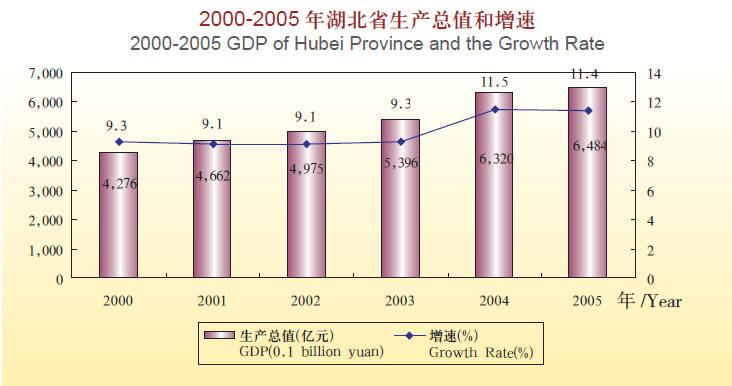
Data of Natural Resources. Industry and Agriculture
Natural Resources
All kinds of natural resources abound in Hubei province, with all its beautiful scenery and mountainous geographical conditions. 138 types of minerals have been found in Hubei, taking up 81% of all discovered minerals nationwide. Among the 138 types of minerals, the reserves of 89 types have been ascertained, for instance, the reserves of five mineral resources including peridotite for fertilizer, iodine, garnet, rectorite clay and diabase for construction use rank top nation wide; the reserves of 17 mineral resources such as marlite, phosphorus etc. are No.2 or 3all around China; also the reserves of 35resources such as iron, copper, gypsum, gold, mercury and manganese rank 4th-10thnationwide.
There are various kinds of animals and plants in this province, with a number of world-rare species and species only can be found in Hubei. The province is also a key base of traditional Chinese medicine, thus called the “China’s herb warehouse”. It boasts abundant water resources which is capable of generating31.334 million KW of electricity. The installed capability developed or under development is27.268 million KW, ranking top nationwide. The Three Gorges Project, presently the largest water-control project in the world, is located in Hubei province, with total installed capability of 18.2 million KW.
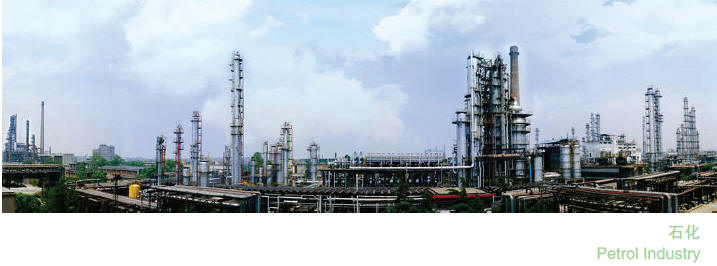
Industry
Hubei has a firm foundation and comprehensive supporting strength for such industries as auto manufacturing, metallurgy, machinery, electric power, chemical industry, electric information, textile and building materials. It is one of China’s three iron & steel bases, with the largest manufacturing capability for medium, thick and thin plates as well as special steel. It is the second largest auto manufacturing base and the largest manufacturing base for medium lorry, heavy-duty machine tools and packing machinery, also for such chemical products as hydroelectricity, alkali, pesticide, phosphorus, salt & chemical and fiber paste.
Also Hubei is one of China’s photoelectron information industrial bases, modernized manufacturing base for traditional Chinese medicine and a key textile base.
Yields of Major Industrial Products in 2005
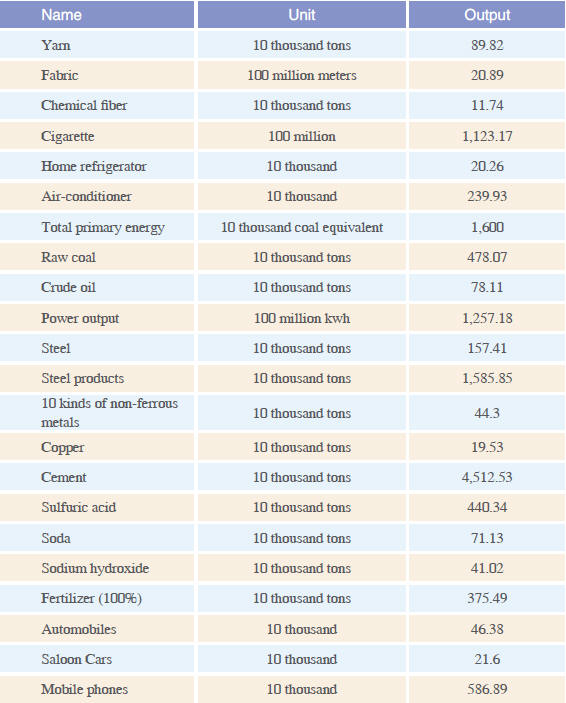
Fix Assets Investment
In 2005, RMB 283.475 billion Yuan has been invested in fi x assets in the whole province, among which investment in real estate development is RMB 47.795 billion Yuan. If classified based on economic types, state-owned investment is RMB109.571 billion Yuan; collective investment is RMB 7.947 billion Yuan; urban and rural individual investments total RMB 55.427billion Yuan; other economic investment is RMB 110.53 billion Yuan. According to industry types, the three types of industries have invested respectively RMB 9.288billion Yuan, RMB 108.805 billion Yuan and RMB 165.382 billion Yuan.
RMB 49.5 billion Yuan has been invested in the 64 key construction projects. Newly added production capabilities include: hot-rolled steel of 500 thousand tons per year, raw coal exploitation of 1.1978 million tons per year, electric-power capacity of 2.76million KW, steel-making of 3.36 million tons per year, and also newly built high way of 296.14 kilometers, program-controlled exchange of 34.3 thousand per year.
Agriculture
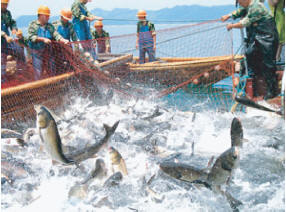

Known as the“ land of fish and rice”, Hubei is one of the key production bases for commodity grain, cotton and oil and the largest production base for fresh water products. The outputs of rapeseed and freshwater fish rankNo.1 nationwide, cotton and rice also on the top level, and there is great potential for the production and processing of agricultural and sideline products.
In 2005, grain-planting area was3.9268 million hectares; cotton planting area 390.3 thousand hectares, and oil plants area 1.4506 million hectares. Total grain output was 21.7738 million tons; total cotton output 375.0 thousand tons; and oil plant output 2.9390 million tons (see the following table for outputs of major agricultural products).
Total forestation area was 186.4thousand hectares in Hubei. Timbers harvested was 1.36 million cubic meters.
Stock raising and fishery have kept growing steadily, with total meat output of3.4263 million tons and water products of3.182 million tons, a record-breaking output.
Power consumption in the country side was 6.845 billion kwh. And fertilizer consumption was 2.8363 million tons.
Outputs of Major Agricultural Products in 2005

Advantageous Industries
As one of the cradles of China’s modern industry, Hubei is also one of the key industrial bases in China. It has built a characteristic industrial system with its advantages in resources all through the years, featuring electronic information, auto manufacturing, iron & steel, and textile manufacturing.
“ China Optical Valley, Wuhan” has been rapidly developed into China’s largest photoelectron information center through development of photoelectron information technologies and optimization of industries, talents and resources. In the past 10 years, the “China Optical Valley” has been growing steady, which has attracted concern of people.
The gross output of machinery and auto industries of Hubei province has reached RMB 140.7 billion in 2005, with added value of RMB 40 billion, sales income of RMB 145 billion, gross profit and tax turn over RMB 12.6 billion. The total profits reach RMB 5.66 billion and the export value is RMB 2.69 billion.
By the end of 2005, the manufacturing capability of complete cars reach 800thousand, with the characteristics of “car, heavy, medium, light and special vehicles” developing simultaneously, with a complete set of“ high, medium and low level” vehicles. Stimulated by the rapid development of complete cars, the parts and components section has expanded gradually, with over 700 such enterprises(among which 310 are large and medium sized),providing a supporting capability for 600 thousand vehicles. Hubei province has an number of large-scale enterprises of auto omponents and parts, which grasp 58 kinds of volnme production of 60 key components and parts mainly supported by the state. These enterprises are famous and play an important role in China. For example, CAAS that is established on the basis of Henglong Jingzhou and three other enterprises through reversed take over and become the first Chinese enterprise to be listed on NASDAQ in the United States, the listing of Dongfeng auto shares in China’s mainland, as well as the listing of Dongfeng Group in HongKong.
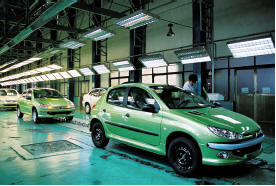
In 2005, there are 433 large and medium-sized auto enterprises in Hubei province, including 9 for complete vehicles,63 for vehicles refitting (3 of which also possess complete vehicles), and 361 for auto components and parts. The total assets are RMB 134.5 billion, with gross industrial out put of RMB 79.92 billion, sales income of RMB 95.05 billion, and profits payment and tax turnover RMB 8.825 billion, and profits of RMB 3.548billion. 389.4thousand automobiles are manufactured, among which there are 141.7 thousand cars. By the end of 2005, there are 193joint ventures in the auto industry in Hubei, with total investment of US$ 6,365.7732million and contracted foreign investment of 1,722.215 million US$.
By the end of 2005, the textile industry of Hubei province has a capacity of 7 million ingots and 70 thousand looms. Large and medium-sized enterprises have the manufacturing capacity of 880 thousand tons of yarn, 2.1 billion meters of cloth and 200 million pieces of garments, with total industrial value of RMB 44 billion, sales income RMB 40 billion and profit payment and tax turn over RMB 1 . 9 billion. There are 73 state-owned and state-holding textile enterprises; large and medium-sized private enterprises take up90%, while state-owned and state-holding enterprises take up 37.8% of total assets, Drivate economy plays a“ leading role” in Hubei textile industry.
Service Industry
Ever since the reform and opening up, the service industry of Hubei has entered into a period of all-around, rapid and sustainable development. The work force of the primary industry and the secondary industry is basically steady. More than 3 million people enter into the service industry for the first time, 300 thousand per year. The service industry become a major channel of employment.
Business Data
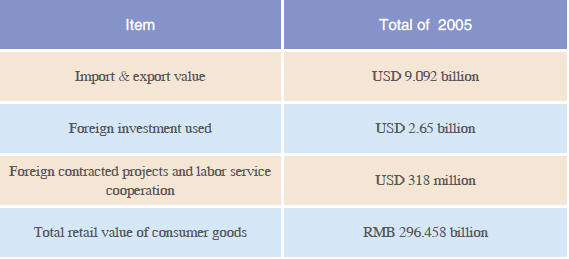
Pattern of Opening up. In 2005, there are 108 development zones, 3 of which are state-level, and other 105 are provincial level. 3 cities are opened up to the outside, together with one international airport, 15 bonded warehouses Station.
There are 13 ports opening up to the outside world, which includes Wuhan Port, Huangshi Port, Yichang Port, Shashi Port, Ezhou Port, etc. Wuhan Customs House is administrative authority supervising import & export in Hubei province, with 7affiliated customs agencies. Hubei Import& Export Commodity Inspection Bureau, with 8 branch offices, is responsible for the inspection of imported and exported commodities as well as plants and animals.
International Trade. The import &export value of the year 2005 was 9.092billion dollars, in which export value amounts to 4.45 billion dollars. The growth rate of import & export and growth rate of export are ranked 4th and 9th in the whole country and first and second in Central China. The exports of iron & steel, ship building, auto and components, electronics, chemical engineering and other advantageous industries are growing powerfully.

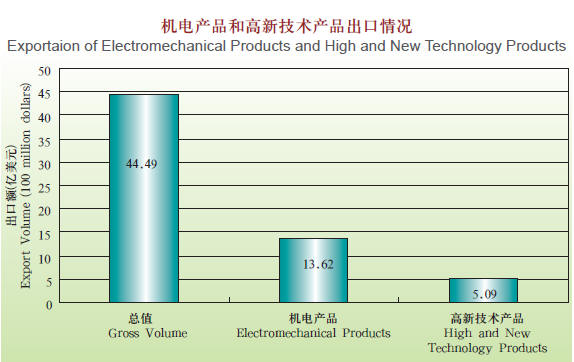
Utilization of Foreign Investment. The actually used foreign investment in 2005 is 2.65 billion dollars. There are 520 projects with foreign direct investment, totaling contracted capital of 2.11 billion dollars, and actually used foreign investment of 2.185billion dollars. Total taxation by foreign invested enterprises reaches RMB7.67billion. There are 314 thousand employees in foreign invested enterprises.
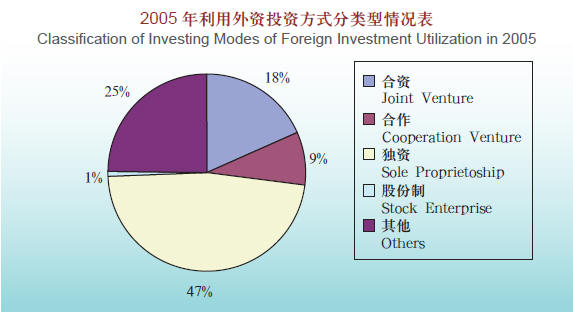
Expansion of Foreign Economic Cooperation Scale. Total turnover of foreign economic cooperation in 2005 has reached318 million dollars; overseas labors reach5, 658 including 1,994 mariners. At the end of the year 2005, 7,599 labors stayed abroad. There are 19 newly sanctioned overseas economic support projects. 10overseas investment enterprises are newly authorized, with contract investment of 5.37million dollars, in which Chinese investment is 5.21 million dollars, involving resource development, exploration and design, as well as manufacturing and processing, playing a proactive role in Hubei’s overseas economic development.
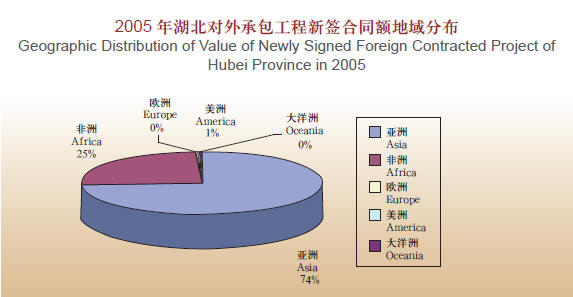
Domestic Trade Keeps Growing. Retailing of social consumer goods in 2005reaches RMB 296.458 billion, total turn over of wholesale and retail trades reaches RMB240.235 billion, and the catering industry has total turnover of RMB 38.665 billion.
Doing Business in Hubei Province of China:I.Survey
Doing Business in Hubei Province of China:III.Investment
Doing Business in Hubei Province of China:IV.Development Zones





